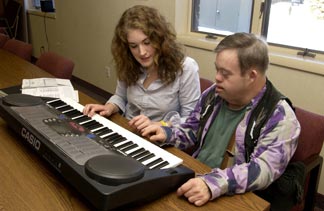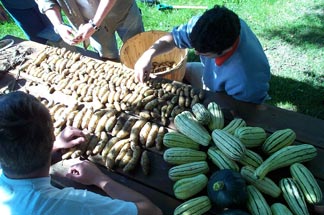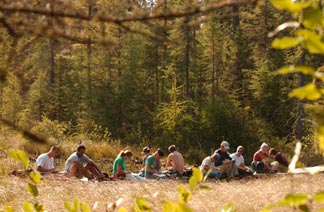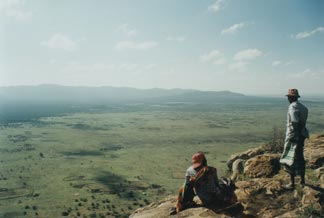Visionary Programs
By Macreena A. Doyle
Bold steps into academic areas no one else was exploring—these programs
have become part of the landscape of St. Lawrence and they’re the
result of faculty vision.
 |
| One
of the components of the First-Year Program course
Our Communities, Ourselves: A Community-Based Learning
Experience required students to spend time volunteering
in the local community. Kaitlynn Reyell ’09, a third-generation
Laurentian from Saranac Lake, N.Y., left, made weekly visits
to the Canton unit of St. Lawrence NYSARC (described on
its own Web site as “an organization serving individuals
with mental retardation and other developmental disabilities,
and their families”). She led numerous activities
involving music; here, she and Ron Middlemiss are learning
the names of the keys on her keyboard. |
The First-Year Program
The “FYP” has become a model for introducing new students to
the academic experience of the liberal arts. It was cited by
the Carnegie Foundation for Excellence in Teaching as “one of the
most well-defined and creative in the country.”
That design involves
four components: students in each "college" live
together; they take a team-taught, interdisciplinary course;
they are assisted in developing written and oral communication
skills, plus research skills; and they are advised by program faculty.
Vice
President and Dean of Academic Affairs Grant Cornwell ’79 says
the FYP “was intended to provide a holistic educational experience
for first-year students. Many other colleges have based their
first-year programs on ours. All marvel at the ambition of
our program, and admire the institutional commitment it represents. The
program has always been a laboratory for innovative pedagogy.” Associate
Dean of the First Year and Professor of Economics Steven Horwitz explains, “Every
faculty member has to teach writing, research and oral presentation.
That has fundamentally changed teaching at the University.”
Mallory
Mumford ’06, of Lowville, N.Y., puts it this way: “The
FYP is the social and educational foundation for the St. Lawrence
experience.”
 |
| St.
Lawrence is the closest American liberal arts college
to a foreign capital – Ottawa, a little over
an hour from campus. |
Canadian Studies
St. Lawrence has recognized the benefits of its proximity to
a foreign nation for years. Since the 1970s, the University
has had a Canadian studies program that is renowned.
The program is interdepartmental,
with some courses taught by faculty in the Canadian studies
department, others by faculty in anthropology, economics, English,
environmental studies, fine arts, global studies, government, history,
modern languages and literatures (French), and sociology.
Professor
of Canadian Studies Joseph T. Jockel ’74, explains, “We
made the decision to capitalize on our location. Our curriculum
allows students to go far beyond the introductory course – a version
of which many schools offer – if they have the interest. And many
do.”
Jockel also notes another, perhaps less obvious, attribute
of the program: “It is truly part of the liberal arts tradition,
which is the University's tradition. By studying another country,
students also reflect on their own country. They must look at American
society, politics, environment, culture and so on.”
 |
| What’s distinctive about St. Lawrence’s
environmental studies program is its equal attention
to the physical and social sciences. The Catalog description
for the course Sustainable Agriculture Systems says it
draws on “perspectives of agricultural scientists,
ecologists, economists, sociologists and philosophers.” |
Environmental Studies
Established in 1973, environmental studies was the University's
first interdisciplinary program. About then, interest in the environment
entered the mainstream, and many colleges added programs. Most were based
in the sciences.
“From the start, we had a different concept of the curriculum for environmental
studies that went beyond what most places simply saw as ‘ecology,’” says
Professor of Environmental Studies Glenn Harris. “We moved into the humanities
well before colleagues at other institutions, for example. Our original five
combined majors show how we were thinking about this – geology, biology,
sociology, economics and government. We later added anthropology, philosophy,
chemistry, English and psychology, and ultimately the stand-alone major.”
Harris
says, “Our location gives us a great opportunity for community
involvement, and our students have undertaken wonderful projects
that have really helped some local towns and villages. Many officials have
told me that without some of the work done by our faculty and students, they
would never have been able to have gotten grants or accomplished projects.”
 |
| For
most students, it’s a rare treat to have class outdoors; for Adirondack Semester students, it’s
unusual to have class indoors. |
The Adirondack Semester
Another feature of the University’s location, its proximity to the
Adirondack Park, provided the catalyst for the Adirondack Semester,
available since 2000. Following the model of study in another culture,
the program offers students the opportunity to immerse themselves full-time
in the natural world. Each fall, about a dozen students live together in
a remote portion of the park, taking four courses taught on-site and going
without cars, television, Internet, alcohol and other accoutrements of
contemporary college life. They also learn outdoor skills such as rock
climbing, kayaking, canoeing and backcountry navigation, and guest artists
perform, to enrich understanding of Adirondack culture. Excursions are
also part of the program, culminating in a two-week field trip to a distinctly
different type of ecosystem.
Professor of Philosophy Baylor Johnson, director
and one of the program’s founders, says, "What makes the Adirondack
Semester distinctive is the combination of academic study fleshed out
by experiential learning. The students live close to nature,
without the distractions of the modern world, while studying natural and
human history, learning about contemporary environmental problems and their
solutions, and expressing what they are experiencing through writing and
art.”
Asked
what makes the program special, Louise Gava ’07, of Clifton
Park, N.Y., replies, “Living between civilization and wilderness
allows for transformation and growth. A perfect semester? Far
from it. Rather, a perfect decision I will be thankful I made for the rest
of my life.”
Kenya Program
While not the first St. Lawrence program of study abroad, the
Kenya semester has become well-known and extraordinarily
popular, as well as being lauded for its academic quality. Established
in 1974, it was the first by an American college to have its own study
base in Kenya. In 2006, the program expands with a Kenya Summerterm.
Headquarters
is in Nairobi, but students spend significant time in the field,
including homestays and two field trips, one emphasizing culture and development,
the other the environment, rangeland ecology and wildlife conservation.
Students also have a three-week homestay with a family in urban
Nairobi, and an internship. The academic program includes two required
courses and two electives; study of Kiswahili, the national language of
Kenya, is also required.
Professor of Anthropology
Alice Pomponio, who has directed the Kenya program, states, “The
rural homestay--a week with a family--is frequently the first time that
our students have been a minority. They are often absolutely overwhelmed
by the genuine hospitality shown to them.”
The academic experience also makes the program stand
out, she says. “Students engage in independent study, which is not
always part of study-abroad experiences, and the academic expectations
are very high – there is total language immersion, which doesn’t
necessarily happen in programs based in Africa,” says Pomponio.
Laura
Dix ’06, of West Windsor, N.J.,observes. “The semester
I spent in Kenya provided life experiences a classroom could
never have given me. I not only learned how to milk a goat
and dig up a sweet potato; I learned about myself.”






